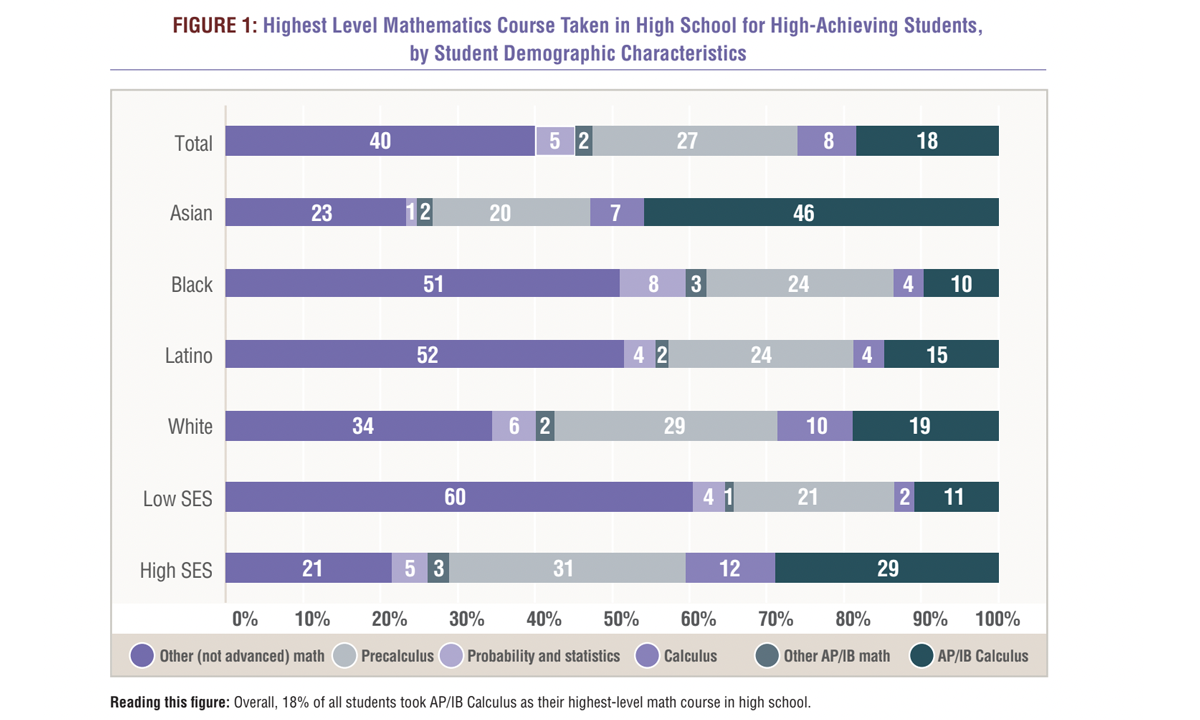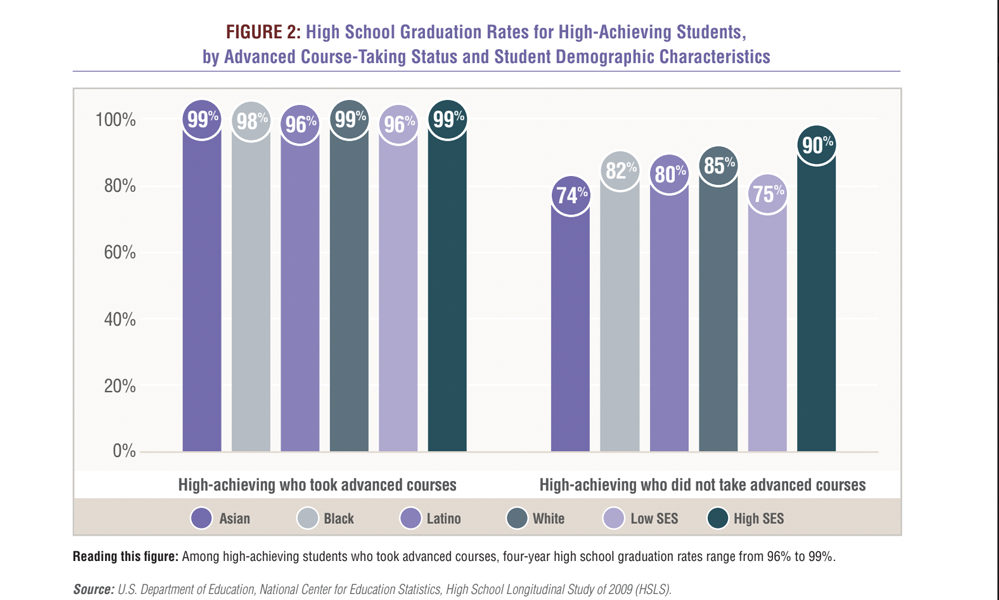Advanced High School Math Classes a Game Changer, But Not All High Achievers Have Access
Academic outcomes surge when high-achieving Black, Latino and low-income students take advanced HS math classes, but often they don’t get the chance

Get stories like this delivered straight to your inbox. Sign up for The 74 Newsletter
High-achieving Black, Latino and low-income students who pass algebra in the 8th grade — a feat that can set children up for success in college and beyond — still end up taking far fewer advanced high school math courses than their white, Asian and more affluent peers, new research shows.
Outcomes are starkly different for those who have that opportunity. High-achieving Black, Latino and lower-income students who do gain access to advanced math classes in high school have better academic outcomes across multiple measures: stronger high school graduation rates, higher GPAs and greater college admission and persistence rates. They were also more likely to attend a highly selective college and earn more STEM credits there, a pathway to landing lucrative jobs in those fields.
Just Equations and The Education Trust released their report Thursday. Together, they analyzed eight years of data following 23,000 ninth graders from 900 private and public schools throughout the country, information collected by the National Center for Education Statistics. The study group was tracked through high school and college starting in 2009.
Both Ed Trust and Just Equations advocate for educational equality with a focus on children who have been traditionally underserved. Earlier research cited in the report shows Black, Latino and impoverished students, regardless of their capabilities, are less likely to be assigned AP math courses, enroll in STEM majors or attend top-tier colleges than their wealthier, white or Asian peers.
“This study challenges the notion that access to advanced math courses is purely the byproduct of talent and academic achievement,” said Melodie Baker, national policy director at Just Equations. “Our analysis confirmed that all too often, factors such as race, wealth and privilege — rather than students’ aptitude and proficiency — can be hidden prerequisites for access to courses that lead to STEM and college opportunity.”
While 46% of high-achieving Asian students, 19% of white students, and 29% of students from high socio-economic backgrounds took college-level AP/International Baccalaureate calculus by the end of high school, just 10% of Black, 15% of Latino and 11% of lower-income high-achievers did the same.

Race and income disparities in high school graduation rates appear to level off for this high-achieving, underrepresented group when they take advanced math courses: 99% of Asian and white students, 98% of Black students, and 96% of Latino and lower-income students graduated in four years. Four-year high school graduation rates declined among all high-achievers who did not take advanced math classes and gaps opened up along racial and socioeconomic lines, although the drop in graduation rates was starkest for Asian students and least-felt by affluent students.
“We know that it is so important for students to feel engaged and that their learning experiences are relevant,” said Ivy Smith Morgan, EdTrust’s director for P12 research and data analytics. “What this conjures for me is the anecdotes about students who are so smart but stop paying attention in class because they are not challenged. They are not getting the opportunities that align with their ability.”
Smith Morgan noted U.S. students’ performance in mathematics as compared to their peers internationally has been highly scrutinized for years, with last week’s release of the latest PISA scores showing unprecedented 13-point declines for American students and an average 15-point loss globally. The U.S., still reeling from COVID learning loss, along with other countries, now ranks 26th in its math scores. Smith Morgan said a failure to mine students’ talents will have dire economic implications.
“What we are talking about is losing a future workforce with the skills, training and technical knowledge we need to fill all of the STEM jobs that will exist — not the ones we have right now, but the ones we have not even thought of yet,” she said. “We are shooting ourselves in the foot.”
The study notes the disparity in opportunity starts well before students enter high school: Just 24% of Black students, 34% of Latino students, and 25% of students from low-socioeconomic backgrounds took Algebra I or higher in eighth grade, compared with 39% of white children, 64% of their Asian peers and 57% of students from higher income backgrounds.
“Anyone who is paying attention knows that our mathematics education systems are deeply inequitable,” said David Kung, director of strategic partnerships at The Charles A. Dana Center in Austin. “Black, brown and poor students get shafted when it comes to access, teaching and advising.”
The Dana Center, which seeks to ensure all students have access to excellent math and science education, has been working with several states across the nation as part of its Launch Years Initiative to revamp mathematics curriculum, making equity and student interest a top priority.
“This report is another reminder that whenever there are decisions to be made — to take algebra in 8th grade, to enroll in an advanced math class, to apply to college, to choose a STEM path — equity gaps open,” Kung said. “We must reform our systems so those critical transitions are smoother, especially for students from groups we have historically under-supported.”
The new study found, too, that high-achieving underserved students who took more challenging high school mathematics coursework often had math teachers who established clear goals and school counselors who set high standards. Such positive influences may have aided in their success.
Researchers say 74% of Black and 81% of Latino high-achieving students who were enrolled in advanced high school mathematics courses went on to follow a standard process of getting into and staying enrolled at college after high school.
Not so for those who did not: Only 58% of Black students and 53% of Latino high-achieving students who did not take these classes had that same outcome. Results were similar for students from lower-income backgrounds: 77% of those who took advanced math courses experienced standard college enrollment and persistence versus 53% who did not take more challenging courses.
The study showed Black and Latino high-achieving students who took advanced math courses in high school had better first-year college GPAs: roughly 0.5 points higher. Lower income students had a 0.6-point gain.
EdTrust and Just Equations recommends Congress support and incentivize state and district leaders to greatly expand access to challenging coursework in all topics, including math.
They said, too, that the government should increase funding for whole-child support services that would allow districts to hire an appropriate number of well-trained restorative justice coordinators, school counselors, psychologists and nurses.
States and districts should also boost professional development efforts and coaching with the goal of reducing bias and incorporating anti-racist mindsets.
They can also automatically enroll students in higher-level math courses, like the Dallas school system, which moved from an opt-in model to an opt-out policy in the 2019-20 school year. The entire state of Texas followed that example: Gov. Abbott, earlier this year, signed a bill that requires the automatic enrollment of children in advanced math based on their test scores, not on a recommendation.
The Commit Partnership, a Dallas-based nonprofit focused on education, applauded the move. Chelsea Jeffery, its chief regional impact officer, said she looks forward to other districts doing the same, not only changing their policies but providing students with the support necessary to graduate high school ready for college and the workforce.
“We celebrate Dallas ISD for their innovative approach to this critical subject area and to policymakers for passing legislation that will benefit our students and community,” she said.
The study classified a student as high-achieving if they passed — with an A, B, or C — Algebra I or higher in middle school. Others who made the cut scored in the highest one-fifth on a math assessment given to students in ninth grade.
Disclosure: The Bill & Melinda Gates Foundation provides financial support to Just Equations, The Education Trust, The Charles A. Dana Center and The 74.
Get stories like these delivered straight to your inbox. Sign up for The 74 Newsletter

;)
